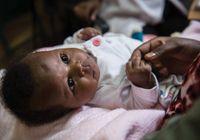
Photo credits: Save the Children/Hannah Maule-Ffinch
Delivery and immediate postnatal care in a health facility or hospital is recommended for all women and their babies, in all situations—including humanitarian settings. However, during and immediately following a crisis, women may not be able to leave their residences to access care in health facilities. In addition, many cultures advocate a seclusion period where mothers and newborns do not go outdoors. This can range from 7–40 days, making seeking care outside the home a difficult negotiation. Note that in some settings, community-based health programs do not exist, thus making it difficult to establish home visits. Mothers should be encouraged to access the health facility within the first week of life, where possible.
Nurses and midwives are not the only staff who can provide postnatal care: CHWs, Home Visitors and other lay health workers can be trained to provide postnatal care at the household level, ensuring that linkages to the formal health care are maintained through an effective referral network (Box 5.3). This type of task-shifting can be particularly useful in humanitarian settings, which frequently experience a shortage of local healthcare workers. Lay health workers can provide: promotion of essential newborn care, exclusive breastfeeding, postpartum care, KMCabbreviation and immunization according to national guidelines.
- Train CHWs, TBAs, Home Visitors and other field-based staff to advise women to seek care at a facility as soon as possible following a home birth through the referral network.
- Simultaneously prepare field staff for the possibility that women will need care in their homes throughout the immediate and longer-term postnatal periods. Develop a home visiting deployment plan that aims to meet the WHOabbreviation recommendation of a minimum of 4 postnatal care contacts during the first six weeks after birth: a first visit as soon as possible within the first 24 hours following birth, a second visit between 48-72 hours, a third visit between day 7-14 after birth, and if possible, a fourth visit during week 6 following birth.
- Ensure that staff undertaking home visits highlight newborn danger signs that the mother and other household members should look out for (See Section 3.2).
- Emphasize the importance of keeping the mother and baby together, especially immediately after birth (see Box 3.2).
- Train all staff present at deliveries in ENCabbreviation techniques (Box 3.1), and to use birth registers to track pregnancies, births (in facilities and in households), postnatal care and referrals within the population segment to which they are assigned.
Box 5.3: Life-saving home visits for mothers and newborns
In crisis settings, women who give birth outside of a health care facility without skilled care, and in areas where continuous professional care cannot be assured, face an increased risk of maternal and newborn morbidity and mortality. Home visits in the first week of life are a proven strategy to reduce newborn deaths in high mortality settings and link women and their babies to ongoing services. Especially in settings where women cannot access health care due to logistical or security reasons, deploy trained CHWs or other skilled health staff to provide postnatal care through home visits. These Home Visitors can detect signs of serious illness in the mother and baby, and reinforce these dangers signs to the mother and other household members (Box 3.3 and Box 3.4). Counseling families on danger signs and available services can increase family-initiated referrals. Home Visitors can leave a poster or card listing the danger signs (including pictorially) and their phone number in case of an emergency. Where insecurity or destruction of roads impedes home visits, other ways to follow up with mother and baby, such as structured phone calls, should be identified. It is important to promote a return to the health facility for a well-baby postnatal visit within the first week as services, security and local customs allow.
WHO/UNICEF Joint Statement, Home Visits for the Newborn Child: A Strategy to Improve Survival, 2009.
Maternity waiting homes have been successfully piloted in some humanitarian settings; however, the current evidence is insufficient to determine whether maternity waiting home improve maternal and neonatal outcomes in crises.
